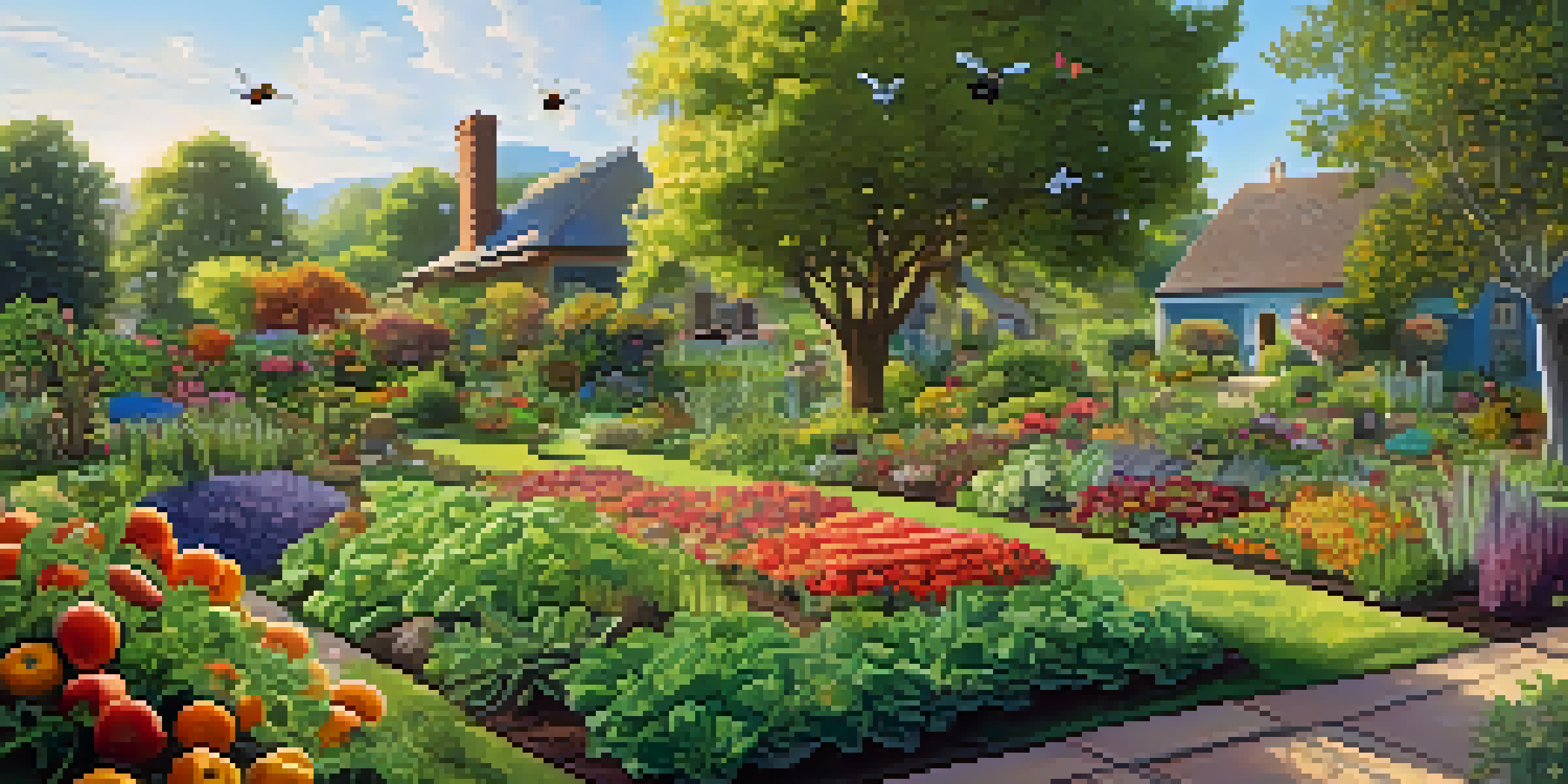Permaculture and Climate Resilience: Adapting to Change

Understanding Permaculture: A Sustainable Approach to Farming
Permaculture is more than just gardening; it’s a holistic design system that mimics natural ecosystems. It integrates plants, animals, and even humans to create sustainable and self-sufficient environments. By observing nature, permaculture practitioners develop systems that work in harmony with the earth, rather than against it.
The greatest threat to our planet is the belief that someone else will save it.
This approach promotes biodiversity, which is crucial for resilience against climate change. For instance, a diverse garden can better withstand pests and diseases, as well as fluctuations in weather. Just like a well-balanced diet supports our health, a diverse ecosystem supports the health of our environment.
Ultimately, permaculture encourages a shift in mindset from conventional farming to a more regenerative practice. It’s about working with nature, not trying to control it. This fundamental change is key to adapting to the challenges posed by climate change.
The Impact of Climate Change on Agriculture
Climate change is reshaping our landscape, posing significant challenges to traditional farming methods. Rising temperatures, unpredictable rainfall, and extreme weather events can devastate crops and livelihoods. Farmers worldwide are feeling the pinch, leading to food insecurity and economic instability.

As a result, there's an urgent need for adaptive strategies that can withstand these shifts. Many farmers are turning to permaculture as a response, employing techniques that enhance soil health and conserve water. This not only helps them cope with immediate climate impacts but also builds a foundation for long-term sustainability.
Permaculture Mimics Nature's Systems
This holistic approach integrates plants, animals, and humans to create sustainable and self-sufficient environments.
By understanding these challenges, we can appreciate the crucial role permaculture plays in developing resilient agricultural systems. It's about preparing for tomorrow while nurturing our environment today. This proactive approach is essential as we face an uncertain future.
Core Principles of Permaculture for Climate Resilience
Permaculture is built on a set of principles that guide practitioners in creating resilient ecosystems. Key principles include observing and interacting with nature, using renewable resources, and valuing diversity. By applying these principles, we can create systems that are not only productive but also robust against climate stresses.
Nature does not hurry, yet everything is accomplished.
For example, water management techniques such as swales can help retain moisture in the soil, making crops less vulnerable to drought. Similarly, planting a variety of species can ensure that if one crop fails, others may thrive. It’s like having a backup plan that safeguards your harvest against unforeseen circumstances.
These principles empower individuals and communities to take control of their food systems. By embracing permaculture, we can cultivate resilience, ensuring that our agricultural practices are not only sustainable but also adaptable to changing climates.
Permaculture Techniques: Building Resilience on the Ground
There are several practical techniques within permaculture that help build resilience against climate change. Techniques such as companion planting, agroforestry, and rainwater harvesting are just a few examples. Each of these methods supports ecosystem health while also addressing specific climatic challenges.
Companion planting, for instance, involves growing different plants together to enhance growth and deter pests. This natural synergy can result in healthier plants and higher yields, which is crucial in unpredictable weather conditions. It’s a bit like teamwork in the garden, where each plant plays a role in supporting its neighbors.
Community Strengthens Resilience
Fostering strong local networks enhances resilience, allowing communities to share resources and support each other in implementing permaculture practices.
Moreover, incorporating trees into agricultural systems through agroforestry can improve soil quality and increase carbon sequestration. By adopting these techniques, farmers can create a more resilient agricultural system that not only withstands climate challenges but also contributes positively to the environment.
Community and Permaculture: Strengthening Local Resilience
Permaculture is not just an individual effort; it thrives in community settings. By fostering strong local networks, communities can share resources, knowledge, and support one another in implementing permaculture practices. This collective approach enhances resilience on a broader scale, making communities better equipped to face climate challenges.
Community gardens and cooperative farming projects are excellent examples of how permaculture can strengthen local ties. These spaces not only provide food but also create opportunities for education and collaboration. It's a reminder that together, we can achieve more than we can alone, especially when facing significant challenges like climate change.
Additionally, engaging in permaculture practices can empower communities to advocate for sustainable policies. When people see the benefits of working together, they are more likely to push for systemic changes that support resilience. This grassroots movement is essential for a sustainable future.
Learning from Nature: Innovations in Permaculture Design
One of the most exciting aspects of permaculture is its innovative approach to design, inspired directly by nature. For instance, observing how a forest functions can lead to the creation of an efficient food forest. This method utilizes layers of plants to maximize space and resources, mimicking the complexity of a natural ecosystem.
These designs often include everything from ground cover to tall fruit trees, creating a self-sustaining environment. It’s like a miniature ecosystem that provides food, habitat, and even beauty, all while reducing the need for external inputs. This aligned design encourages resilience by fostering a diverse and balanced environment.
Innovative Designs Inspired by Nature
Permaculture utilizes nature-inspired designs, like food forests, to create efficient and self-sustaining agricultural systems.
By learning from nature, we can develop solutions that are both effective and sustainable. This innovation is crucial as we seek to adapt to a changing climate. It reminds us that nature has been perfecting these systems for eons, and we can harness that wisdom to create better agricultural practices.
The Future of Permaculture in a Changing Climate
As we look to the future, the role of permaculture in addressing climate change will only grow in importance. With increasing awareness of sustainability, more people are recognizing the value of these practices. This shift in mindset can lead to broader adoption of permaculture principles, paving the way for resilient communities.
Moreover, integrating permaculture into educational programs can equip future generations with the skills needed to face climate challenges head-on. By teaching young people about sustainable practices, we can foster a culture of resilience that lasts for decades. It’s about planting the seeds of knowledge today for a more sustainable tomorrow.

In conclusion, permaculture offers a hopeful path forward in the face of climate change. By embracing these practices, we can create systems that not only survive but thrive, ensuring a healthier planet for generations to come. It's an exciting journey that invites us all to participate and innovate.